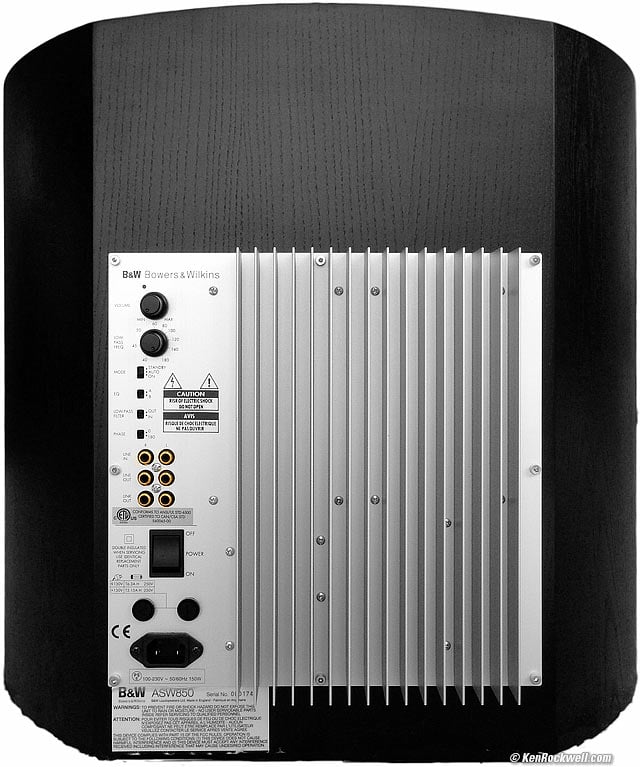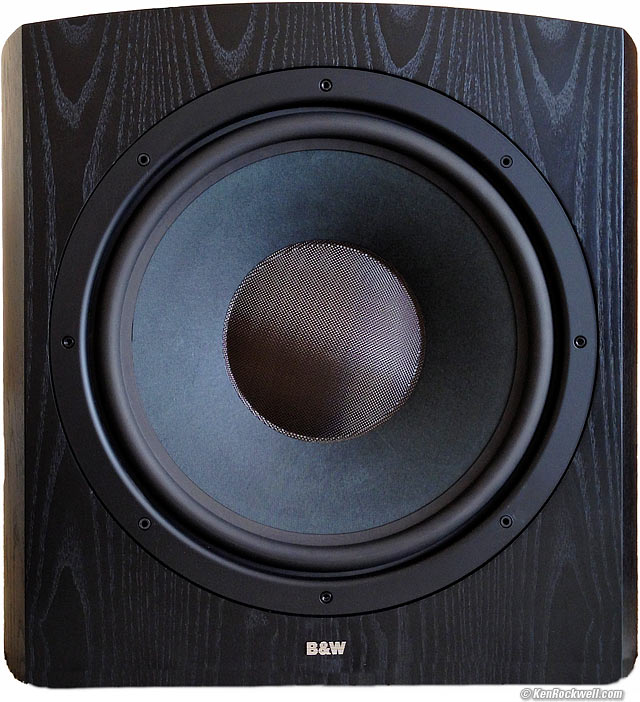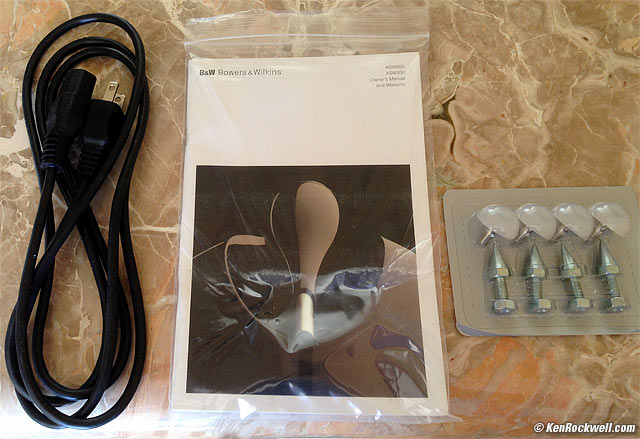Home Donate New Search Gallery Reviews How-To Books Links Workshops About Contact
B&W ASW850
15" Active 1 kW Subwoofer (2003-2006) MADE IN ENGLAND
© 2015 KenRockwell.com. All rights reserved.
Intro Specs Measurements Compared Usage Recommendations More
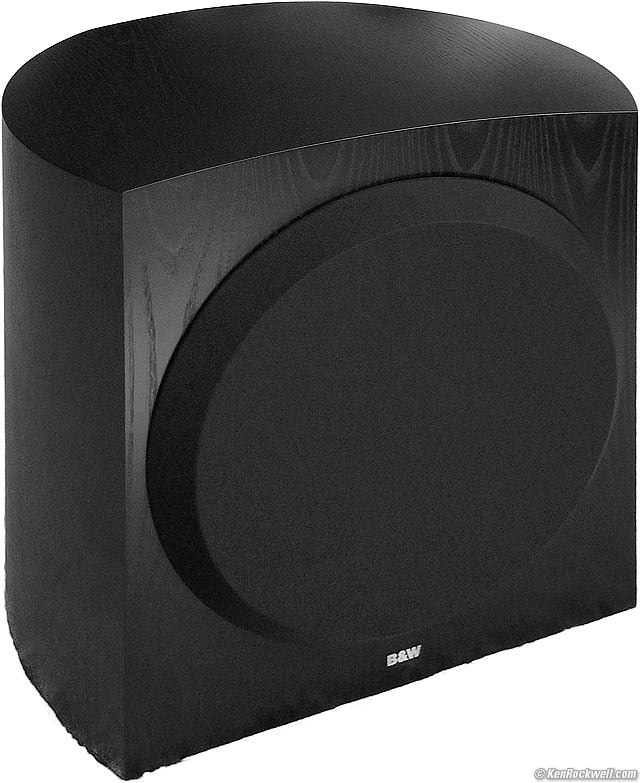
B&W ASW850 (15" driver in sealed 20.8 x 22.1 x 20.6"/529 x 562 x 522 mm cabinet with 1kW amplifier, 99 lb/45 kg, about $1,700 used). I got mine at this link directly to them at eBay (see How to Win at eBay).
May 2015 All Reviews Audio Reviews B&W Reviews
Back, B&W ASW850. enlarge.
B&W ASW850. enlarge.
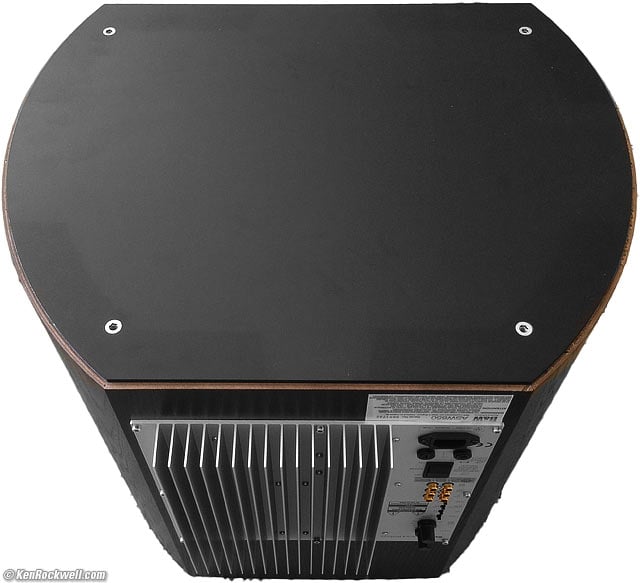
Bottom view, B&W ASW850.

B&W ASW850 next to a CD for comparison.
The B&W ASW850 in a fine home. bigger.
Introduction top
Intro Specs Measurements Compared Usage Recommendations More
|
Adorama pays top dollar for your used gear. I use these stores. I can't vouch for ads below. |
I'll get very technical below, but for those of you who just want a great subwoofer, I've never heard anything better than the ASW850. At this level, if it doesn't sound astounding in your own home, it's because it hasn't been placed correctly in a good room — and if that's your problem, no woofer will sound any better. The ASW850 reproduces the entire bass and musically significant subsonic range cleanly, naturally, smoothly and effortlessly. Other subwoofers can rattle windows, while the ASW850 will do it all day without breaking a sweat.
This is what most people would call a big subwoofer, but this is what a subwoofer is supposed to be. It really comes into its own when asked to reproduce music below the range of the bass guitar. 32-foot ranks of pipe organ, synthesizers and thunderous effects from 16 to 40 Hz are where the ASW850 produces huge amounts of clean output that most speakers and other subwoofers can't even dream of reproducing.
The ASW850 goes an octave below what most other common "subwoofers" can reproduce.
Also impressive is how fast and easy it is to get the ASW850 to work perfectly with main speakers. It usually takes a long time to get any given pairing of subwoofer and main speaker to work seamlessly. With the ASW850 and the B&W 802 with which I tried it, I simply ran the main speakers as usual and fed the ASW850 from the same preamplifier signal. I set the ASW850 to kick-in where the main speakers quit at 40 Hz, and voilà, perfect sound fast. Ditto for tiny desktop Monitor Audio Radius 90 speakers, I set the crossover higher so the ASW850 only fills-in where it's needed.
The B&W ASW850 is a real hundred-pound Made-in-England subwoofer which enjoys reproducing the deepest bass and infrasonics. It's not some wimpy vented-box made-in-China imitation that poops out as soon as the bass makes it into real subwoofer territory below 30 Hz.
The bass is half the music, so especially if you've only got wimpy speakers like the B&W 805, you need a pair of woofers like this.
B&W created this to pair with their exotic Nautilus series, which are already full-range speakers. This ASW850 is to let those, or other speakers, reach all the way down into subsonic territory and dig up the deepest bass you probably never knew was there. The Nautilus sold for $40,000, and this ASW850 was good enough to augment the Nautilus' bass.
The B&W ASW850 loves to get down and dirty, cleanly reproducing the lowest and loudest musical fundamentals and infrasonics you probably never knew your recordings had, all with ease.
The deeper the music gets, the louder the ASW850 plays. With the ASW850, you're always hearing the fundamentals, not just the harmonics. There is never any distortion or doubling; just powerful, deep, clean bass without any strain, ever.
The ASW850 has no resonances and just thuds where it needs to, never adding its own coloration or changing the pitch.
I prefer crossing this woofer in below 40 Hz to reproduce only the lowest bass when used with with decent full-range speakers like the B&W 802. For the ASW850, bass guitars are trivial; standard 4-string bass guitars and stand-up basses don't even play as deeply as 40 Hz; the ASW850 kicks in and gets busy below where the basses usually stop!
The ASW850 is built like a tank. Its curved sides don't vibrate at all to the touch when the woofer cone is moving a half-inch or more in and out. I can feel a tiny bit on the top, which for all I know is the entire woofer bouncing up and down on my flexing floor, but the cylindrical sides don't vibrate at all. The ASW850 uses internal Matrix bracing to prevent this, as well as using curved walls.
The woofer cone looks like paper, but it's actually paper and Kevlar. It feels more like thick cardboard or a thin sheet of wood veneer than just paper.
The 1,000 watt amplifier is silent; there's no buzz or hiss even if you stick your head to the woofer cone.
The ASW850 really does flap pants. I was running some test tones through it, and i looked down at my shorts, and they really were visibly flapping from all the sound level at very low frequencies!
Big thuds
Big happy bottom
Good auto power detect, just turns on relay without delay or thumps
Momentary lapse/dogs of war
6' flexible two conductor power cord
Input overloads at less than 1 VRMS at 20cps in A
Specifications top
Intro Specs Measurements Compared Usage Recommendations More
Driver
15" (380mm).
Paper/Kevlar cone.
Rubber surround (not foam).
Frequency Response
Frequency Range: 14 - 140 Hz at -6dB.
Frequency Response: 18 - 110 Hz ±3 dB.
Internal Amplifier
Power output: 1 kW (1,000 watts).
SNR: > 90 dB.
Internal Crossovers
Low pass: 12 dB/octave, 40-180 Hz continuously variable.
High pass: 18 dB/octave, fixed at 80 Hz.
Power Input
Two-prong polarized standard HP power cable.
100-230V, 50-60 Hz.
Rated 150 watts power consumption.
See also actual measured power consumption.
Colours
Black Ash (shown), Cherrywood or Red-Stained Cherrywood.
Black grillcloth.
Included Accessories
B&W ASW850 included cord, manual, rubber feet and spikes. enlarge.
The included cord is quite nice. It's only 6 feet (1.8 meters) long, but very soft and flexible.
Base Thread Pitch
There are four M6 (6mm maximum thread outer diameter x 1.0mm pitch) threaded inserts on the bottom to attach the rubber floor bumpers or spikes included above.
Size
20.8 x 22.1 x 20.6 inches HWD, including front grille and rear controls but excluding any screw-in feet or spikes.
529 x 562 x 522 millimeters HWD, including front grille and rear controls but excluding any screw-in feet or spikes.
Weight
99 pounds (45 kg).
Packed shipping weight: 108 pounds (49 kg).
Price
October 2013: about $1,700 used, USA.
2003-2006: $3,000 new, USA.
Measurements top
Intro Specs Measurements Compared Usage Recommendations More
These are real 545-point stepped-sine anechoic measurements made with an exotic Rohde & Schwarz UPL laboratory analyzer.
Sensitivity
10 mV at 100 Hz produces 90 dB SPL at 1 meter in anechoic half space with the gain control in the center (12 o'clock) position.
31.6 mV leads to 100 dB at 1 meter at the 12 o'clock gain setting.
With the gain control in the 9 o'clock position, 100 mV at 100 Hz produces 100 dB SPL at 1 meter.
Maximum Input
Oddly the input will clip if the input level is too high, regardless of the setting of the level control. The maximum input level is the inverse of the amplifier's response curve. The internal equalization is before the level control.
| Maximum input at 0.1% internal THD | |
| 16 Hz | 458 mV |
| 20 Hz | 406 mV |
| 25 Hz | 464 mV |
| 32 Hz | 603 mV |
| 40 Hz | 760 mV |
| 50 Hz | 928 mV |
| 63 Hz | 1.098 V |
| 80 Hz | 1.26 V |
| 100 Hz | 1.37 V |
| 125 Hz | 1.48 V |
| 160 Hz | 1.56 V |
| 180 Hz | 1.59 V |
| 200 Hz | 1.61 V |
Maximum Output
Whatever it is, it's more than I felt like measuring. I don't like having to stick my fingers in my ears at the same time I'm holding an SPL meter, and I didn't want to get my shooting hearing protectors to keep my hands free. The ASW850 will put out more than anyone needs for music.
With an 8,000 cubic foot (225 m3) listening room, there is more than more than enough output at any frequency, even using just one ASW850. In America, too much is never enough, but in this case, it's plenty.
I wasn't able to get it to distort at moderate frequencies I suspect the amplifier has a limiter to reduce gain as necessary in case of stupidity.
With test tones at low frequencies, I could get it to distort. It turns out that the built-in preamplifier and equalizer, before the level control, will clip a bit below 1 V RMS input around its maximum boost at 16 Hz. This means that if you're driving the ASW850 from a test generator and setting the gain at the low end of the range, the distortion you're hearing is your own fault; lower the level of your test generator and set the ASW850's gain control about midway and the distortion goes away!
At 20 Hz, a 100mV input at the center gain setting attempting 120 dB SPL knocks off the grille and distorts! 31.6 mV gives an undistorted 100 dB SPL, and 56 mV distorts slightly at 105 dB SPL.
Frequency Response
I'm impressed: it reasonably meets its response claims down to 14 Hz! Speakers usually lie about bass performance, so this is encouraging.
My measurement preamp is down 0.5 dB at 20 Hz and 1 dB at 14 Hz, and my measurement mic is down 0.5 dB at 20 Hz. Therefore, add 1 dB at 20 Hz.
These are measured in the BYPASS position for the low-pass filter. Response extended to about 160 Hz, and was down about 20-30 dB by 300 Hz.
Like most good subwoofers, the ASW850 uses internal equalization to get the response flat to lower frequencies. The amplifier applies a lot of low frequency boost, and the 1 kW amplifier and sturdy driver suck it all up with aplomb.
There are two EQ settings: A and B. The A setting gives the flattest, deepest bass, while the B position doesn't extend the low frequency response as much in exchange for the ability to play louder for most music.
In the A position, the ASW850 applies the most boost at 16 Hz; God bless B&W!

Frequency response at 2 meters, half-space anechoic, "A" EQ setting, 16-120 Hz.
Compensated, I see ±3 dB down to 20.5 Hz in the A EQ position.
It drops at about 6 db/third octave, or 18 dB/octave. It wants +18 dB at 12.5 Hz, +12 dB at 16 Hz, +5 at 20 Hz and -3 at 40 Hz.
With the SH-8065, set 16 Hz to +12 dB and 40 Hz to -5 dB to get abotu this.
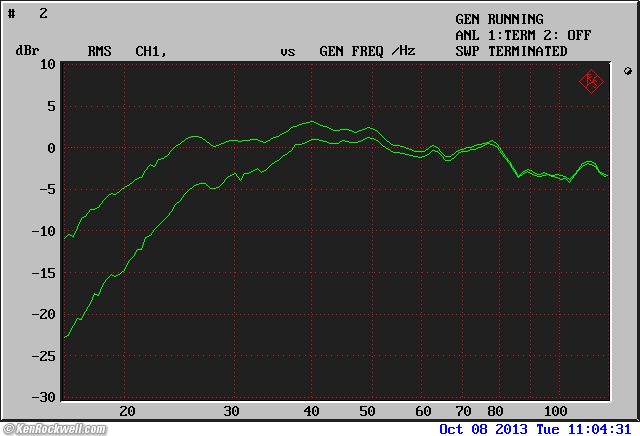
Frequency response at 2 meters, half-space anechoic, "A" (upper) and "B" (lower) EQ settings, 16-120 Hz.
The "B" EQ position removes the subsonics, so that what you can hear can play even louder at the higher frequencies where most music lies.
Because of the bass cut in the B position, response measures ±3dB down only to 28 Hz.
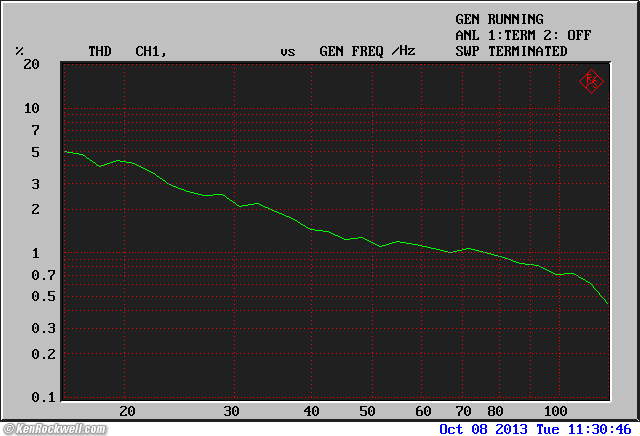
THD at 90 dB SPL at 1 meter, 16-120 Hz. (90 dB SPL set at 100 Hz, actual SPL varied with frequency as shown above.)
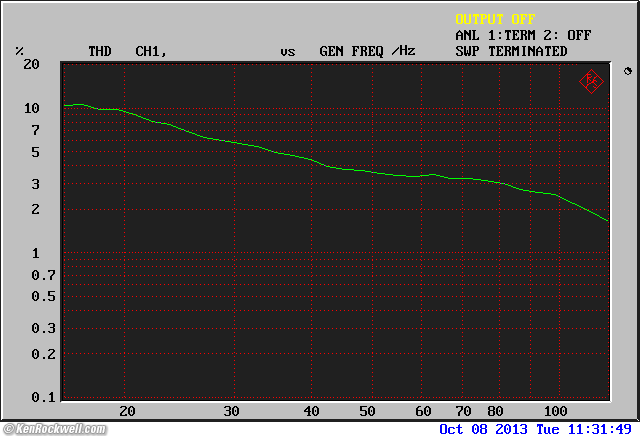
THD at 100 dB SPL at 1 meter, 16-120 Hz. (100 dB SPL set at 100 Hz, actual SPL varied with frequency as shown above.)
0 watts, switched off (no pilot light).
2.2 watts in standby (red LED, standby or sleeping).
20.7 watts at idle (green LED, ready to play).
22 watts playing at reasonable or loud levels.
About 90 watts playing music as loud as you can.
550 watts or more playing subsonic test tones.
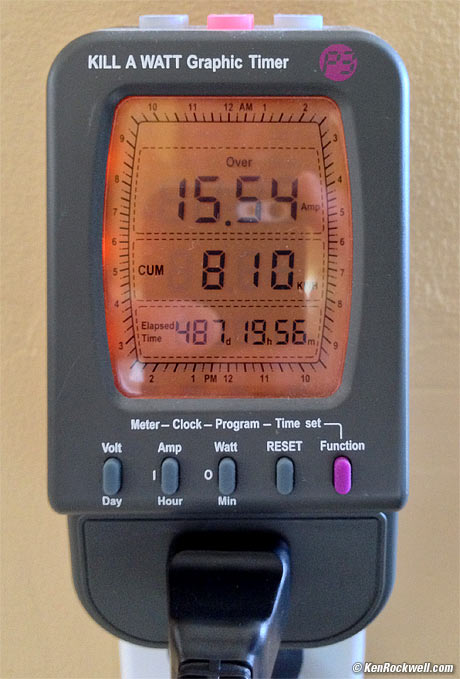
The B&W ASW850 can draw enough power to trip safety devices if you attempt to abuse it.
Playing abusively loud subsonic test tones, my safety breaker blew and my power meter said that it was drawing 15 amperes as it was cut-out.
The ASW850 will cut itself off if you do something really stupid and your power breaker doesn't blow first. If the ASW850 cuts itself off, turn the big power switch off and on to reset
Magnetic Fields
The ASW850's big magnet isn't shielded, so keep it away from color CRT displays.
I measure as much as 600 µT (6 Gauss) around the top and sides of the ASW850. Directly in front, I measure as much as 1,400 µT (14 Gauss).
Driver in Box (no amplifier used)
Here's measurements of the raw driver in the box, in other words, measuring what the amplifier is driving:
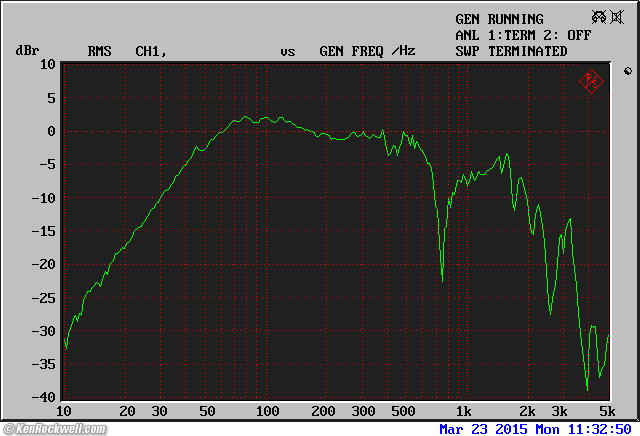
B&W ASW 850 driver-in-box close-miked frequency response.
The blip at 48 Hz is probably a wall at about 10 feet.
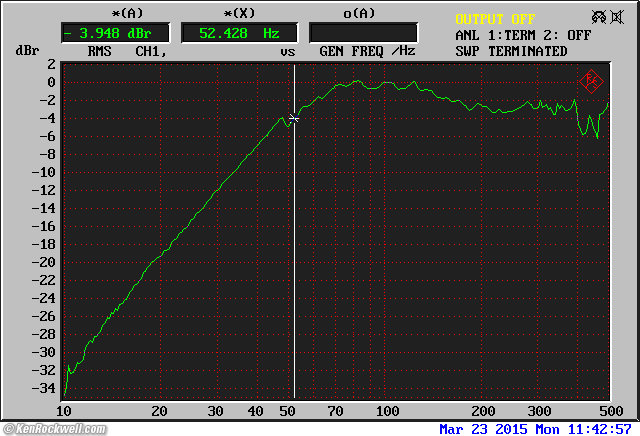
Detail, B&W ASW 850 driver-in-box close-miked frequency response.
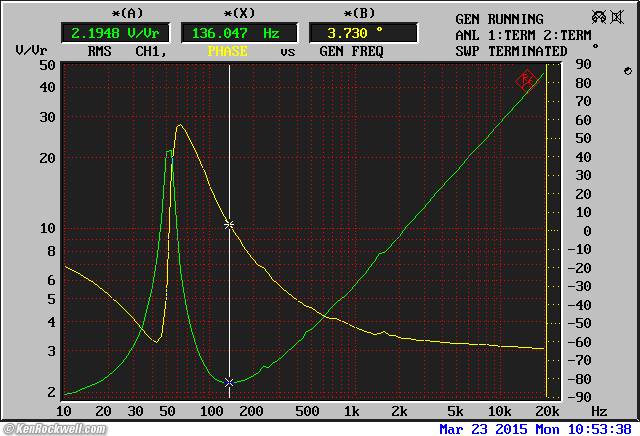
B&W ASW 850 driver-in-box Impedance, measured in-room.
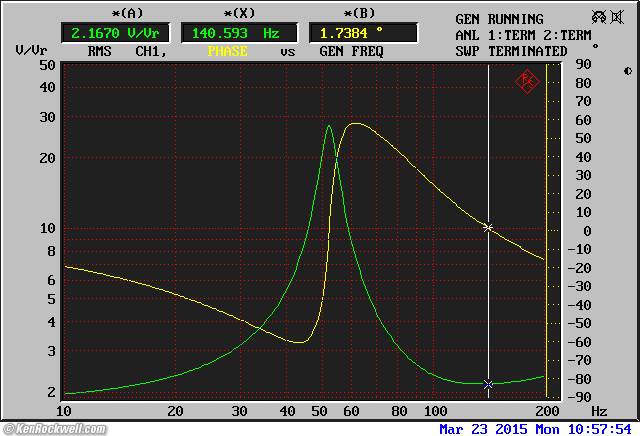
B&W ASW 850 driver-in-box Impedance, detail showing minimum.
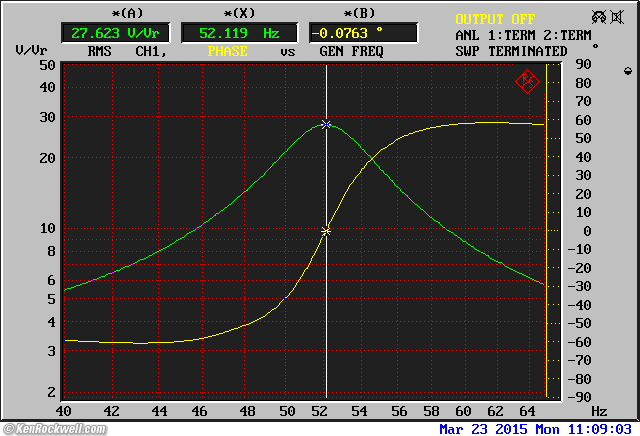
B&W ASW 850 driver-in-box Impedance, detail showing resonance.
Amplifier Only (with driver connected)

B&W ASW 850 amplifier response,16-100 Hz, driving driver in box.
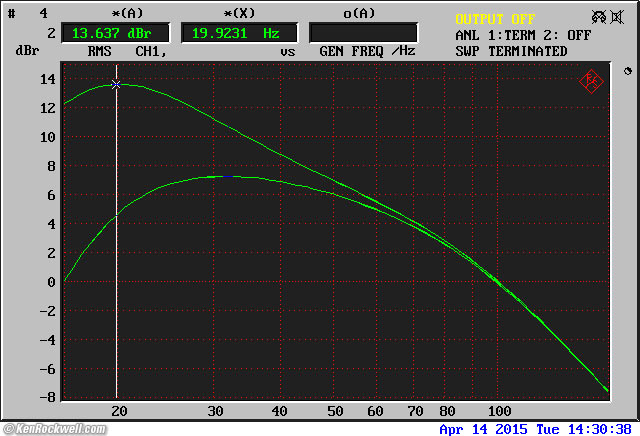
B&W ASW 850 amplifier response, 16-160 Hz, driving driver in box.
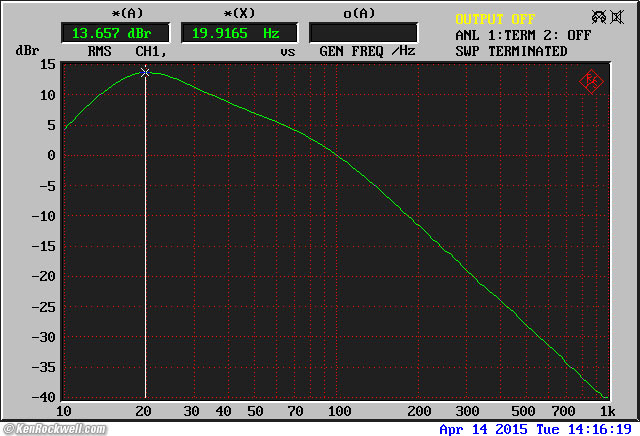
B&W ASW 850 amplifier response,10-1,000 Hz, driving driver in box.

B&W ASW 850 amplifier response 2-200 Hz, driving driver in box.
Compared top
Intro Specs Measurements Compared Usage Recommendations More
The ASW850 has a performance envelope far exceeding a typical excuse for a home theater subwoofer. This beast can pound its 15" driver with what looks like an inch of excursion near 20 Hz, and it shakes the walls and furniture with no distortion or effort. It just goes and goes, with far more output at far lower frequencies than any reasonable home music lover could want.
Consumer attempts at subwoofers, even for thousands of dollars, usually just go "blat blat blat" when trying to play 20 Hz sine waves at audible levels, while the ASW850 just belts it out easily.

B&W ASW850 and similar but smaller ASW800.
The 77 pound ASW800 (on right) uses the same 1 kW amplifier with slightly different frequency calibration, with a 12" driver and about 67% the acoustic output of the ASW850.
The ASW750 has the same box volume and amplifier as the ASW800, with a slightly different driver. Its specifications are the same as the ASW800.
The ASW855 is the same as this ASW850, with a slightly different cone material.
The ASW825 is the same as the ASW800, simply with a different cone material.
The 800 ASW is a completely different vented design not related to the ASW800. One is 800 ASW, the other is the ASW800.
I have not compared this to the JL subwoofers. I lost interest in JL when I discovered that they deliberately cut response below 20 Hz, which to me, is the whole point of a subwoofer. Music is written down to a 32-foot C0 pedal, or 16.35 Hz. JL considers the range below 20 Hz as noise, while I consider it music. (As a bass player, I consider the range above about 3,000 Hz as noise — cut that!)
Usage top
Intro Specs Measurements Compared Usage Recommendations More
Unpacking
Put the box upside-down, with the bottom up. Open the bottom flaps, remove the bottom foam, turn each box over where you want each woofer, and voilà, your ASW850s are sitting right where you want them.
I got mine from a random stranger over eBay, and it was still new and unopened. I think my package was marked the wrong way; it told me to open the end which revealed the top of the speaker.
Placement
Few nonprofessionals have any idea how critical is placement.
A small 8" subwoofer placed well in a good room will sound far better than this extraordinary subwoofer put in the wrong place or used in a poor room.
Don't put on the spikes (if you use them) until you've spent a few weeks listening and moving the woofers around for the best sound.
This beast doesn't need no stinking corner reinforcement to have enough power. If you increase the level to get the right output in your preferred listening spot, other places may wind up having astounding amounts of bass!
Try to keep the subwoofers near each of your main speakers to keep the wavefronts coherent. For instance, if you have the subwoofer several feet further away than your main speakers, you may get a big suck-out at 60 Hz, requiring setting the phase switch to 180º to remove the response dip. That seems reasonable, until you realize that having your woofer further away is delaying your bass by an additional several milliseconds or a significant portion of a wavelength, which does nothing to give you the tight, coherently bass you deserve.
Pilot Light
Off is off (no power consumption).
Red means the woofer is in standby ( 2 watts power consumption).
Green means the subwoofer is on. (about 22 watts power consumption at idle or playing at reasonable levels.)
Power Switches
There are two power switches.
There is a big square rocker switch and a little slide switch. Flip the big one to ON and the little one to AUTO.
The big rocker switch is a regular switch. Leave it on; it's just a way to disconnect the subwoofer completely if you're leaving it for a long time.
Once the subwoofer is plugged in and the big rocker is turned on, the pilot light lights.
The little slide switch has four positions: STANDBY, AUTO and ON.
STANDBY is a silly setting. It forces the ASW850 to stay in STANDBY (red light) mode, and not turn on. The only reason for this position is working in a laboratory where you want to mute the system while changing connections.
AUTO is the correct setting. In AUTO, the ASW850 turns ON (green light) as soon as it gets any signal, and goes back to STANBY (red light) after a few minutes of no signal.
ON forces the system ON at all times.
Stereo Sound
Ideally you should use two subwoofers for stereo.
If you use only one subwoofer, be sure to cross it over as low as possible (like 40 Hz) so that you are turning as little of the bass into mono as possible.
Built-in Crossover
The built-in crossover is all you need for simple installations. Simply feed the signal from your preamplifier to both your main power amplifier as well as the ASW850's input. My Apt preamp has dual outputs, if your's doesn't, use a piggyback cable to send the output to both places.
I wouldn't bother with the built-in high-pass crossover. I see no reason to run my main signal to a subwoofer and back. If you want better sound, use an external crossover:
External Crossovers
See the crossovers section of Stereo Subwoofers.
Crossover Frequencies
Set the crossover to 40 Hz for most uses. If you're using small speakers like the 805, set it higher, typically to the rated low frequency cutoff of your main speakers.
Try setting the crossover to 40 Hz even with smaller speakers and increasing the subwoofer level for a smooth crossover at the higher cutoff frequency of the smaller speakers. This can get you a smooth crossover and a big boost in response below 40 Hz.
Using higher crossover settings will get more boom, as opposed to deep bass, out of the ASW850.
Levels
B&W suggests starting at the 12 o'clock setting and going from there.
I find if you're using this with a typical main amplifier and speakers that that's about right, which is a load of bass. I usually have to turn it down from 12 o'clock.
Recommendations top
Intro Specs Measurements Compared Usage Recommendations More
I love this woofer. It's the first commercially available subwoofer I've heard in a long time that deserves to be called a subwoofer, as opposed to a flimsy imitation.
If you think you want one, you'll love it!
The ASW855 is the same thing, simply with a different cone material.
Seeing how even just one ASW850 is more than enough for even a large room, I suspect the ASW800, which has 67% the output, ought to be more than enough as well. Likewise, the ASW750 and ASW825 are just about the same as the ASW800.
If you've found all the time, effort and expense I put into researching and sharing all this, this free website's biggest source of support is when you use these links, especially this link directly to them at eBay (see How to Win at eBay), when you get anything, regardless of the country in which you live. Thanks! Ken.
More Information top
Intro Specs Measurements Compared Usage Recommendations More
Help me help you top
I support my growing family through this website, as crazy as it might seem.
The biggest help is when you use any of these links when you get anything, regardless of the country in which you live. It costs you nothing, and is this site's, and thus my family's, biggest source of support. These places have the best prices and service, which is why I've used them since before this website existed. I recommend them all personally.
If you find this page as helpful as a book you might have had to buy or a workshop you may have had to take, feel free to help me continue helping everyone.
If you've gotten your gear through one of my links or helped otherwise, you're family. It's great people like you who allow me to keep adding to this site full-time. Thanks!
If you haven't helped yet, please do, and consider helping me with a gift of $5.00.
As this page is copyrighted and formally registered, it is unlawful to make copies, especially in the form of printouts for personal use. If you wish to make a printout for personal use, you are granted one-time permission only if you PayPal me $5.00 per printout or part thereof. Thank you!
Thanks for reading!
Mr. & Mrs. Ken Rockwell, Ryan and Katie.
Home Donate New Search Gallery Reviews How-To Books Links Workshops About Contact

